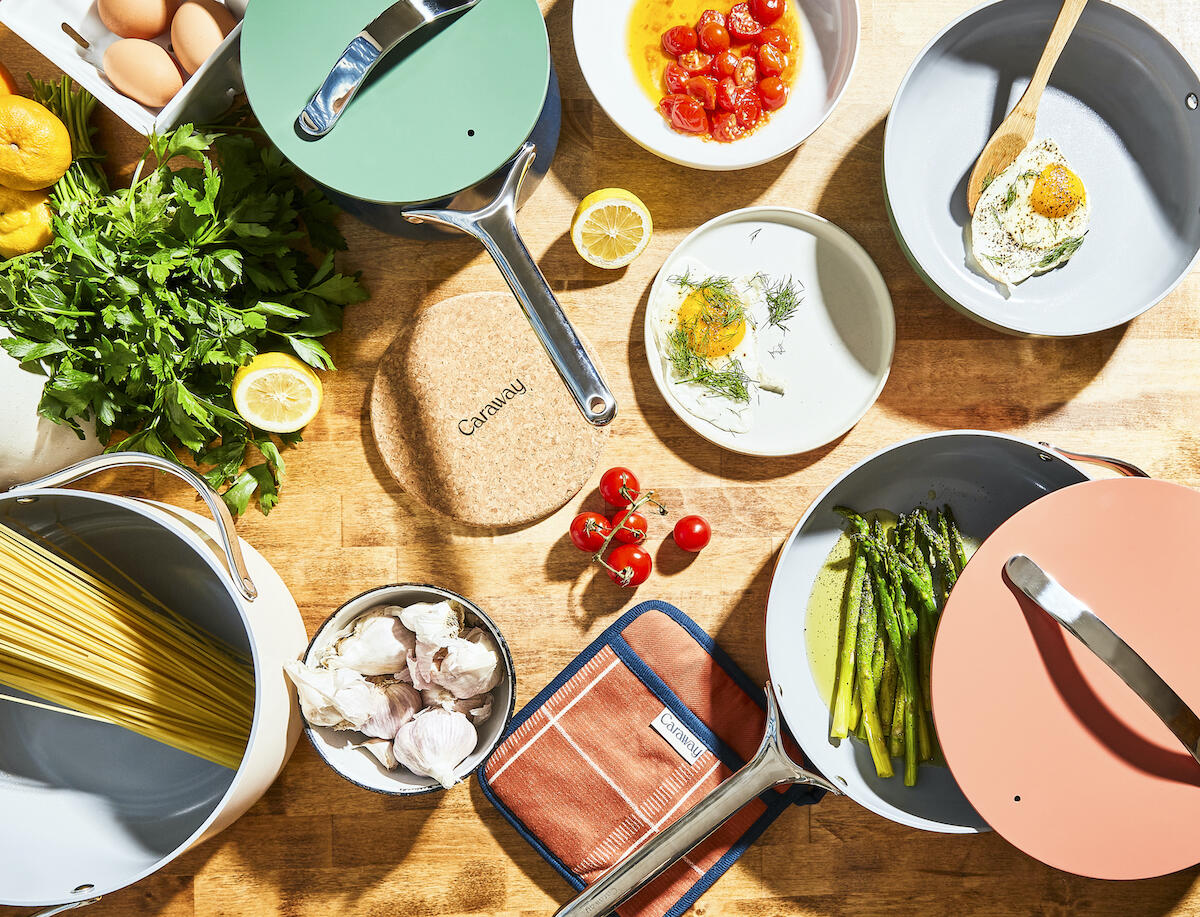For a recent crop of popular direct-to-consumer home brands, the axiom “Quality over quantity” has taken on new meaning—not just sage shopping advice, but a raison d’être. By focusing on a highly curated assortment of products, such companies marketed their goods as the answer to decision fatigue among consumers overwhelmed by a saturated home market in categories from upholstery to paint to kitchen essentials. But from a business perspective, the inevitable challenge soon arrives: How do you scale up if “more stuff” goes against your brand’s core values?
According to Polly Wong, president of direct marketing firm Belardi Wong and an expert in the DTC space, it is simply not possible to grow your business unless you also grow your product assortment. “If you think you’ve got the greatest pan in the world, and then somebody else comes along with the greatest pan in the world, you really do not have a sustainable business plan unless you’ve got multiple products, and even across multiple categories,” says Wong.
For brands with a curated concept, the challenge lies in expanding without betraying the company’s ethos and alienating the customers that hopped aboard early, when the mission was still crystal clear.
The story behind cookware company Caraway begins with a call to poison control. In late 2017, Jordan Nathan accidentally left a nonstick frying pan coated with Teflon on the stove. Forty-five minutes later, the fumes in his apartment led to a case of nausea so serious it prompted Nathan to phone the specialists, who pointed out that his overheated pan may have been the culprit. In 2019, Nathan launched DTC brand Caraway to provide a ceramic-based nontoxic cookware alternative to the Teflon-coated products that dominated the market.
A little more than a year later, the company closed a $5.3 million funding round with more than 100 contributors, including traditional venture capital funds, angel investors and individual entrepreneurs. While the company sold exclusively from its site for the first few months, Nathan knew from day one that broadening its online distribution points was a clear route to reaching more consumers online. Today, Caraway products can be found on sites like Amazon, Crate and Barrel and Williams-Sonoma. Many other formerly DTC companies have followed suit and are no longer technically “direct to consumer” only: You can find Parachute linens and Great Jones cookware at Nordstrom, and Casper mattresses made a deal with West Elm to sell its products in stores and online before graduating to a similar partnership with Target.
Choosing to expand beyond the brand’s initial, very narrow distribution channel was one relatively painless way to grow. But the bigger challenge, Nathan says, was finding a way to expand Caraway’s product assortment without letting go of the brand’s curated concept.

Instead of accruing SKUs into the hundreds and thousands, the company’s product strategy focuses on developing “hero” products—pieces Nathan describes as “high-impact items that can drive a lot of revenue and have a big impact on the environment and people’s health.” The brand’s products are a bigger purchase for consumers (its cookware and bakeware collections go for nearly $400), but they are also a one-time upfront purchase. It is an advantage for the company from a cash flow perspective, as it is not relying on subscription fees to trickle in or smaller incremental purchases spread out over time. Plus, rolling out smaller, more spaced-out launches also allows the company time to collect consumer feedback and fine-tune its offerings accordingly.
“It takes so much time and effort to launch our product, so we wait it out a bit more than most other brands to give them time to breathe [and to] give us time to learn: Why are people buying? What fixes can we make? Did we get the pricing right?” says Nathan. “It takes six to 12 months to get a product to a maturity standpoint before we can launch the next one.”
Caraway may have started as an idea for one great pan, but expanding into new categories like bakeware and linens has been the company’s biggest long-term strategy for scaling up. It is why Nathan named the company Caraway Home instead of, for example, Caraway Cookware, he says. Though it is a $5 billion market, cookware, Nathan notes, was only meant to be a launching pad for the brand.
“We see ourselves building a pretty wide brand that customers come to and buy most of the products they need for their home and kitchen,” says Nathan. “I think a lot of the successful brands out there who are multibillion in size have been successful across categories. That’s really where we are tremendously focused.”
Scaling up with a major funding round under your belt is one thing, but doing it while bootstrapped is another game entirely. When now-CEO Nidhi Kapur launched hand-crafted furniture company Maiden Home in 2017—in part as a reaction to the big-box retail approach to product development, which she believes creates merchandise that is “not thoughtful, and not very differentiated”—she promised early customers that the brand would focus on quality above all else, “whether it be growth or our own ambitions, or really any other trade-off you might make.”
“This is something that was a theory at the beginning, but now has really played out,” says Kapur.
Earlier this year, Maiden Home’s leadership team began dreaming of taking the brand through a period of rapid growth via the straightest route to scaling up there is—quickly expanding the company’s product assortment. But without funding to hire teams of product designers and pay for expensive prototypes, Kapur began looking to the industry for alternatives.
How do huge brands scale their assortment quickly? Mostly, by white labeling—taking preexisting merchandise and remarketing it as your own product. But as Kapur began investigating the process, she decided against it out of concern that any drop in quality would tarnish the brand.

“We know that if we could snap our fingers and, overnight, triple the size of the assortment, our business would be bigger,” says Kapur. “There are a lot of ways to shortcut the process and launch more products more quickly. Ultimately, we made a conscious choice not to go down any of those roads this year.”
Kapur argues that forsaking quality for volume could have been fatal for a brand that relies on returning customers so heavily: Repeat business drives a third of Maiden Home’s revenue. However slow the product development process may be, she reasons that it pays off in trust built with an increasingly clued-in consumer base that is conscious of the environmental and ethical compromises inherent in ultrafast production processes.
Kapur is now exploring alternative paths to growth, including a test run for a new distribution channel. To get even closer to the consumer, Maiden Home decided to launch a recent pop-up brick-and-mortar showroom in New York as a cost-effective testing ground for scaling up in the real-life retail realm—a measured risk that Kapur says may serve as proof of concept for a permanent space.
Debuting a brand with a curated product offering can be a compelling starting point (“Here are perfect linens—the only ones you’ll ever need!”), but it can also set the company up for disappointment among consumers when, inevitably, future growth requires an expanded product portfolio—one that does not always live up to the hype of a brand’s initial launch (“Now we’re making toasters too”). Bret Recor, founder of industrial design and brand strategy firm Box Clever, likens the challenge to that of a fast-rising rock band. After spending years on a great first album, they are met with major success and a sudden influx of fans, and the popularity pushes them to put out a second album. That second project, however, might be more of a middling debut than the first—which only makes sense, since less time and effort was poured into it.
DTC companies are vulnerable to the sophomore slump, says Recor, but they’re also uniquely positioned to avoid it. Brands that have sold directly to consumers tend to have, well, direct relationships with their consumers that big-box retailers do not. “All the brands we work with, they hear from the customers, [and] they’re asking for [certain] products,” says Recor. “You don’t have to go very far to validate something when your existing customers are telling you, ‘We’ll buy it.’”
When launching DTC paint company Clare in 2018, founder and CEO Nicole Gibbons had a handle on where the company’s product road map was headed before the first cans of paint ever hit the virtual shelves. After launching with a curated selection of just 55 colors, the company added to its assortment through customer-focused voting campaigns and by introducing products in related categories, such as outdoor paint and painting supplies. In doing so, Clare set out to grow its tightly edited assortment gradually by cultivating a closer relationship with customers—a strategy that built on its promise of offering a less overwhelming paint-buying process compared to existing old-school options.
Most recently, an $8 million funding round led by Pendulum has allowed Gibbons to scale the company along several new avenues. With the new capital, she plans to expand further into new product categories, test out new marketing channels and look toward diversifying distribution—all moves toward Gibbons’s bigger vision for the brand. (Despite entering the industry as a DTC brand, she has always had aspirations for Clare that extend beyond direct digital sales.) “I started this company to reimagine the way people buy paint, not to build an online paint company,” says Gibbons. “The goal with Clare has been to build a mass brand with omnichannel distribution where we’re meeting customers where they want us.”
While securing a major funding round powers a company’s ability to explore growth beyond a curated concept, in recent years, an increasing number of startups are ignoring big investments altogether in favor of slow growth. According to Nick Ling, CEO of holding company Pattern Brands, the dominant DTC playbook five to 10 years ago saw brands securing large funding rounds—a move that, for many, spurred a push for growth too soon and an earlier breaking point for brands that started with small teams, operations and product portfolios.
“Now, most of these consumer brands can develop a good product and are then able to grow profitably slowly over time,” says Ling. “[They can] be much more thoughtful about how they build their business without that pressure of a large amount of capital behind them.”
Launched in 2019, DTC home brand Material Kitchen is a good example. The company debuted with a line of kitchen essentials (its sleek set of three knives garnered the most attention) and kicked off with a mix of funding from friends and family, as well as some contributions from venture and angel investors. The company broke even within two years of operating and has since opted for a slower path to growth that has included expanding its product selection largely by tapping into the everyday lives of the brand’s CEO and founder, Eunice Byun, its small seven-person team and its customers.
“As the company and the brand have evolved, we’ve really thought about how we can excite and inspire home cooks. A lot of the time, that’s through the lens of storytelling, so it’s not just about the product, details or dimensions,” says Byun. “We don’t approach it from a market size perspective. It’s very much driven by a need and want on a personal level in the kitchen.”

The company’s newest launch demonstrates this approach: a Material Kids collection, featuring games and minisized kitchen tools. After cooking more with her two daughters during the pandemic, Byun noticed that the joy and messiness of the process often contrasted with the sleek and well-produced cooking content seen online. “There was this lightbulb moment of, ‘Oh, my gosh, there’s so much spontaneity that happens when you’re cooking with kids in the kitchen,’ and we just thought, ‘Wouldn’t it be fun to remind people that mistakes or messes in the kitchen—that’s not always a bad thing,’” says Byun.
Uniting a small and nimble team under a shared community-focused goal allows the company to react organically to user feedback, taking consumer product suggestions into account and jumping on opportunities for greater visibility. When the team noticed that influencers were posting photos of their knives on another brand’s cutting boards, they decided to roll out a cutting board as well. Plus, thanks to the company’s DTC structure, Byun says the company is primed to grow through product innovation instead of reaching for growth through more frequent launches.
“Traditional brick-and-mortar brands are bringing new products to market because they have to show something new to the backers each season,” says Byun. “We don’t have to follow the same rubric because we aren’t selling it through those traditional channels at the same drops that everyone else needs to be thinking about.”
However, when small startups begin to experience growth as they expand beyond their first hit item into new products and new channels, the demands of scaling up can prove to be more than they bargained for. At that point, holding companies like Pattern Brands—which acquires smaller DTC businesses under one umbrella, with access to shared resources for operations, tech and marketing—are becoming an increasingly popular exit strategy for early-stage companies on the cusp of growth. “If you build a really good product, and you build trust with the consumer, your brand doesn’t need to grow like a rocket ship to last for a very long time,” says Ling.
In the startup funding landscape of a decade ago, the rise of tech titans like Facebook, Uber and Airbnb still loomed large, and the e-commerce realm still felt ripe for disruption. In the years since, small DTC companies can launch operations more easily without venture capital or major funding, thanks to the technological infrastructure of e-commerce platforms like Shopify (which now hosts nearly 2 million brands, up from just under 20,000 a decade ago). Today, instead of the new frontier, the landscape is something closer to Main Street USA—but that does not mean that mom-and-pop shops do not have a chance at growing into sizable companies with staying power.
“Small businesses are able to build a great consumer brand and reach anyone because of all these tools and technologies that allow you to do this—and because of that, there are less really big outcomes, but there are a ton more smaller brands being created,” says Ling. “It’s more like building a small family business over time: You build it slowly, you create something really special.”
Homepage image: Material recently debuted a collection of cooking tools for kids | Courtesy of Material Kitchen



























